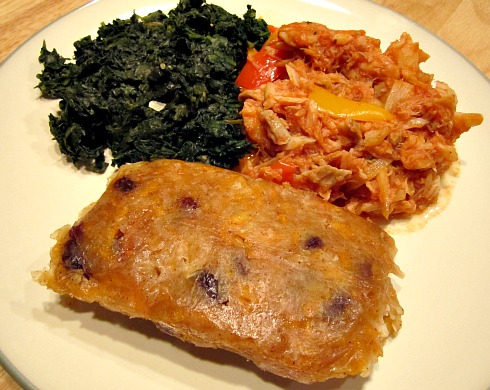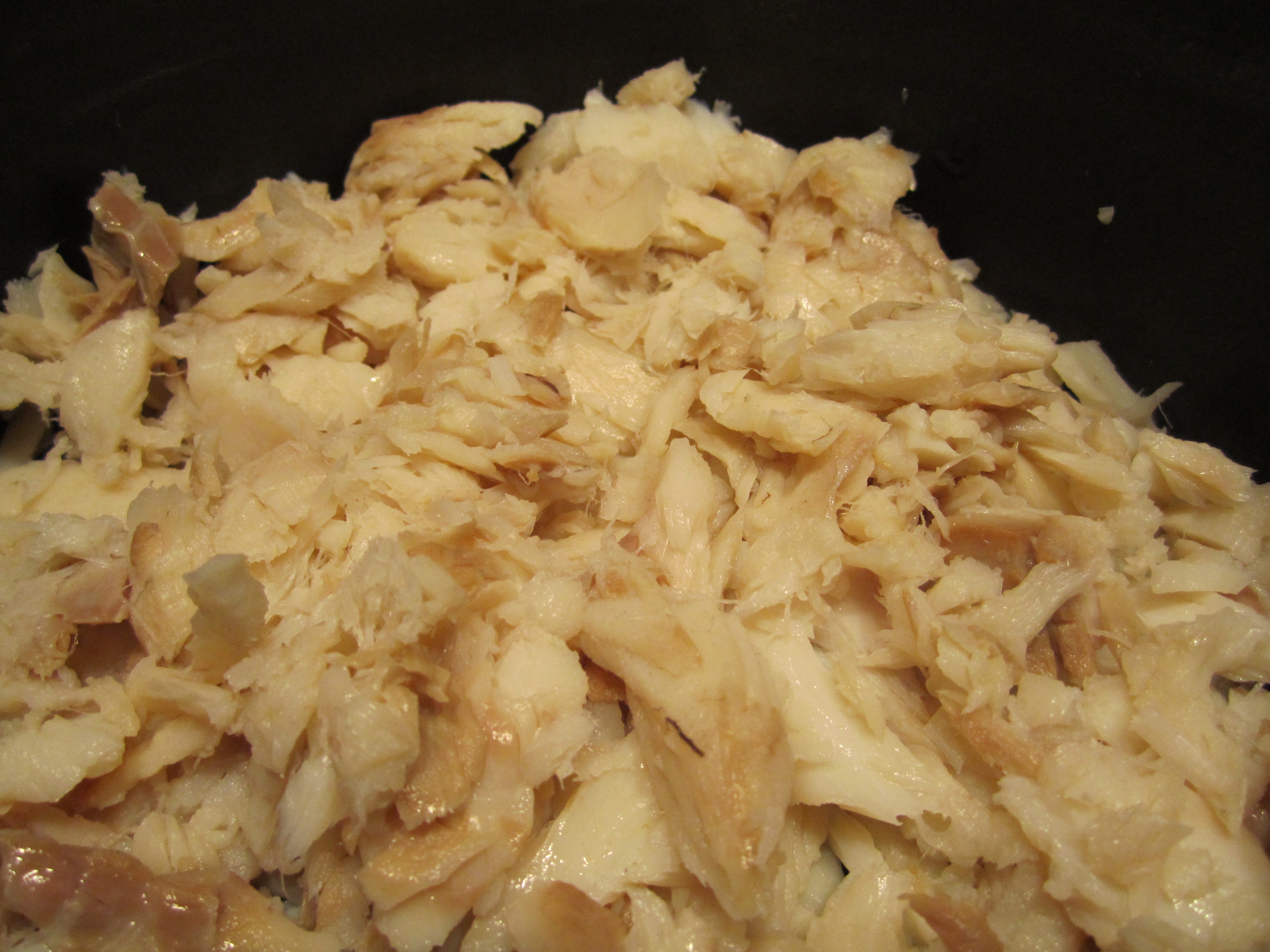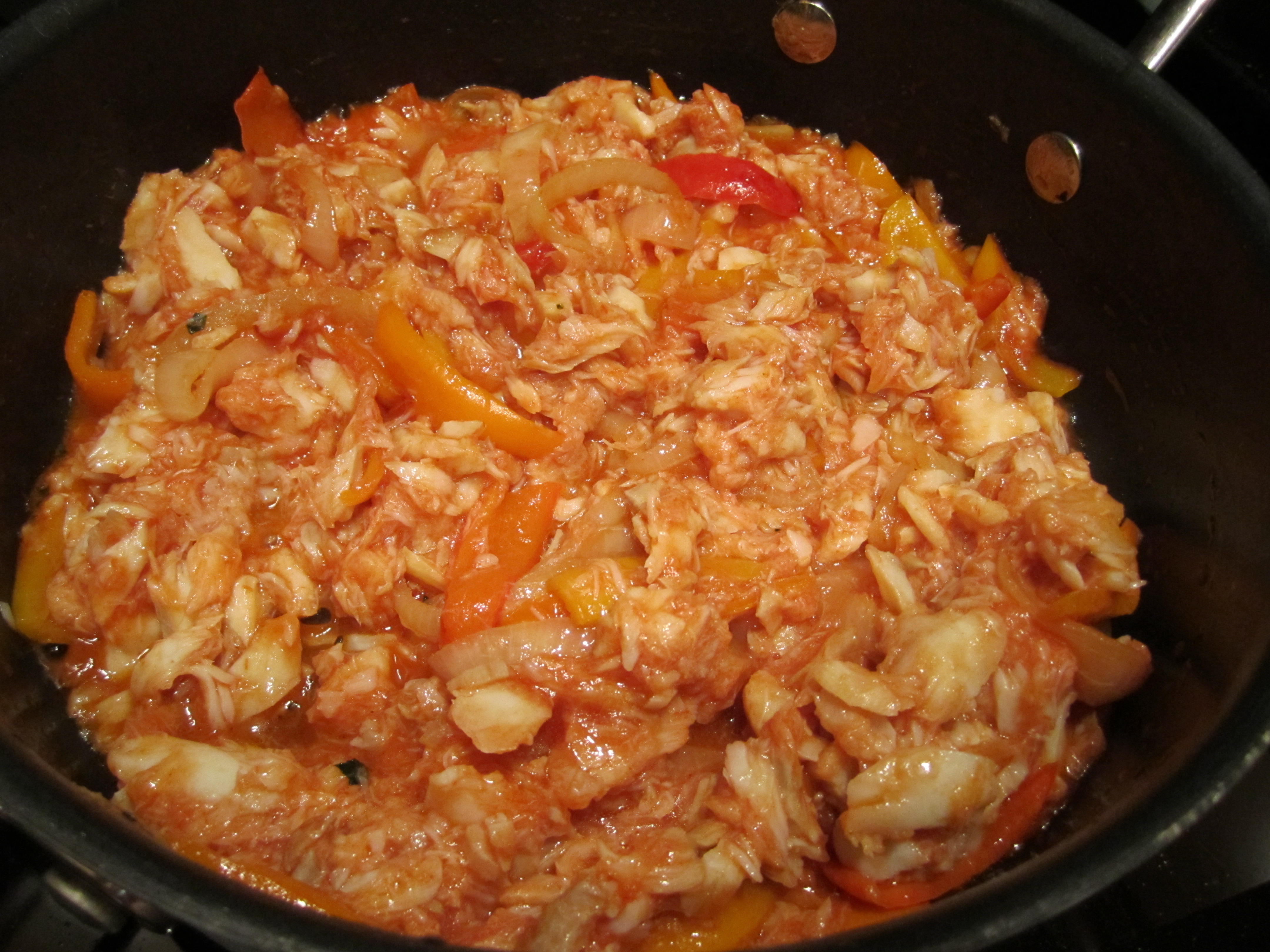
Two things you may have never heard of: 1. Ducana and 2. Salt Fish! Well, now is your chance to learn about one of the yummiest meals you will ever have. I am totally serious. Salty, sweet, savory…if you can think of it, this meal has it. So let’s all thank Antigua for making this one of their famous local dishes. In fact, while Justin and I were on vacation in Antigua last year, all of the locals we spoke to told us to go try it out. Unfortunately for that occasion, we keep kosher and were unable to give it a shot. I never really thought of recreating this seemingly complicated dish on my own until I started writing this blog.  So here it goes!
Salt Fish
1 pound mackerel (original recipe calls for cod-fish but my grocery store was not carrying it at the time I made this recipe)
A lot of sea salt (to make the salted mackerel)
1 medium onion, cut into rings
1/2 of a green, red, and yellow pepper, cut into strips length wise
2 cloves garlic, sliced thin
1/4 cup vegetable oil
1 8-oz can tomato sauce
2 Tbsp apple cider vinegar
1/4 tsp black pepper
Ducana
2 cups sweetened coconut flakes
2 cups grated sweet potatoes
1 1/2 cups water
2 cups sugar
1 tsp cinnamon
1 tsp ground nutmeg
1 Tbsp vanilla extract
1 cup raisins (my favorite part)
1 1/2 cups flour

 I might just be making the assumption that kosher grocery stores in my area just don’t carry salt fish but if I’m wrong, you let me know. So I figured I would just make it myself. Not much to it really, just fish and sea salt. Easy. 24 hours before I planned to make the delicious Antiguan local dish, I poured a thin layer of salt on the bottom of a pan. I then washed and dried the fish, being careful not to tear the fillets, and placed the pieces on top of the salt layer. I completely covered the surface with more salt and tossed  until they were covered on all sides. I tightly wrapped the pieces in plastic wrap, making sure that all the air was out, and placed them on a dish. If you would like, you can place the fish on a rack with a plate underneath it to catch the moisture released during the drying process. I thought just putting the fish on a plate was fine and it worked for me. I placed the plate in the fridge and let it be for 24 hours. Just be careful when you lift the plate 24 the following day since there will be liquid underneath the fish. You don’t want fish juice all over the floor, right?!? That smell would never go away.

 So 24 hours later, I took the fish out of the fridge and I was really excited to feel its texture. Just as promised, the salt pulled tons of moisture out of the fish and I was left with two perfectly dried out fillets. One of the recipes I read said to flip the fish half way through the drying process and re-wrap, so you can do that if you want but I didn’t bother. I soaked the fish pieces in water for about 4 hours then boiled them in water for 45 minutes.

 While the fillets were boiling, I began prepping the vegetables for the salt fish and the sweet potato mixture for the ducana. I sliced the peppers, onions and garlic and put them aside.

One of the ducana recipe I found said to chop the coconut and sweet potato in a blender. That didn’t work out too well. Maybe a food processor would have worked better, but I was just trying to follow directions.

So I switched to manual grating. It was a bit more hands on, but worked much better.

I added 1 1/2 cups of water to add moisture. I then mixed all of the other ingredients in the bowl in the order they appeared on the list. So simple and easy. Since there are no eggs in the recipe, you can even try the mixture before boiling to make sure you like the taste. If you don’t want it to be too sweet, you can add less sugar (maybe 1 1/2 cups instead of 2).

While all of this was happening, the fish continued to boil. So before I cooked the ducana mixture, I took the fish out of the water, drained it and added cold water so the fish could cool. Then it was back to the ducana…I placed a large pot of water on the stove to boil. Meanwhile, I used 8 pre-cut 10×12 pieces of foil paper to wrap the mixture. Using a large spoon, I scooped the batter into the center of the foil then folded it 2/3 of the way, covering the mixture.

I folded the top 1/3 of the foil over the mixture, making sure to pin the end of the batter so it didn’t ooze out either side. I folded in each end to seal it all in.

I repeated the process 7 more times and was ready to boil!

I placed the foil packets in the boiling water, which was ready and waiting for me, and moved back to the salt fish, which had cooled down. I broke the fish into bite size pieces and set it aside. I just had to try it before it was all dressed up, and it was so delicious. Very salty! I guess that’s why they call it salt fish.

I poured the oil in a frying pan on medium-high heat and added the prepared peppers, onions and garlic. I stirred until the vegetables were translucent.

I added the tomato sauce, vinegar and fish to the pan and sprinkled in the black pepper. I stirred everything together and let the mixture sit on the stove over medium-low heat until the ducana were done boiling.

In Antigua, this dish is traditionally served with spinach seasoned with butter to taste, so I took a bag of frozen spinach out of my freezer and cooked it in a pan with a little bit of butter, salt, pepper and garlic powder. You can add cooked pieces of pumpkin, eggplant, okra, or long squash to the spinach. In Antigua, they call it ‘chop up.’ Once the spinach was finished cooking, the ducana packets were ready to come out of the boiling water.

And everything was ready to serve! The ducana was very sweet and textured with coconut and raisins, the salt fish was savory and salty, and the spinach balanced everything out. It was certainly not the healthiest meal I ever had, but it was one of the most fun to make. All I needed was the Caribbean outside of my window! Maybe soon…
Kitchen Tested
Ingredients
Instructions

 Save Recipe
Save Recipe
